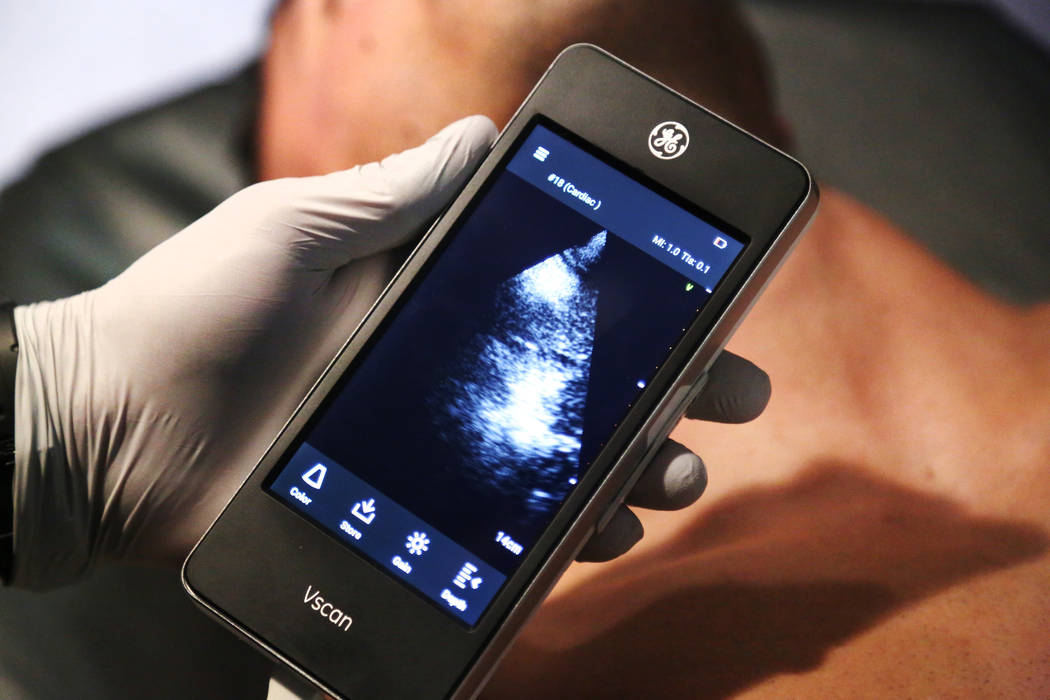CSN paramedic students 1st in state to train on portable ultrasound

College of Southern Nevada paramedic students are the first in the state to begin training on portable ultrasound machines that can help diagnose traumatic bleeding long before a patient arrives at an emergency room.
Students in uniform practiced with the handheld devices for the first time Tuesday at CSN’s Charleston campus. The devices, which will help first responders determine how to care for patients and where to send them, can also communicate patient information to emergency room doctors during transport, expediting the arrival process.
In cases where paramedics suspect trauma or internal bleeding, an on-the-spot diagnosis can get patients to appropriate care within what industry professionals call “the golden hour.”
“If we have a decision to make in the field, one hospital may not have the trauma surgery capabilities that are needed,” said Braiden Green, CSN’S program director of emergency medical services. “This allows us to decrease the amount of times … that a patient is moved, to get the patient to definitive care faster and improve patient outcomes.”
In rural Nevada, an on-the-spot diagnosis could determine whether a helicopter is needed, Green said, one big reason that CSN decided to pursue this technology.
CSN received a $315,000 grant from the Governor’s Office of Economic Development to purchase the ultrasound units, train faculty and students and develop a program with Valley Health Systems Graduate Medical Education program to train emergency room physicians.
The class at CSN might be the first use of the technology in emergency conditions in Nevada, possibly as early as this summer, according to spokesman Richard Lake.
A 2015 study by the Canadian Agency for Drugs and Technologies in Health found that portable ultrasounds are not widely deployed: Just 4 percent of emergency medical services directors in the U.S. and Canada reported using them, though 21 percent said they would if they were available.
Major barriers to access include the cost of the machines and training and inconclusive evidence that the devices improve patient outcomes.
What they can do is influence patient care, the study found, by preventing unnecessary procedures such as a needle stick to treat a suspected collapsed lung and by allowing paramedics to expediently administer time-sensitive medications.
While diagnosing trauma is the primary application for CSN students, the same technology can be used to diagnose traumatic cardiac arrest or for obstetrics purposes.
CSN’s paramedic medicine program began in 1992 and sees anywhere from 20 to 36 graduates per year.
Green said there is an extreme need in Nevada for not only more paramedics, but programs to train them. In April, Las Vegas Fire and Rescue held a job fair to seek more paramedic staffers, and in the past, Nevada has faced shortages of emergency medicine professionals.
“We cannot fill that need fast enough,” Green said.
Mike Figiels, a student who has been in the program for 10 months, said he works for the Henderson Fire Department and decided to enroll in the program to expand his skill set.
In his work, he has seen cases where the ultrasound units would have been a boon.
“Basically (in situations) when we’re seeing blood where there shouldn’t be blood,” he said.
Contact Aleksandra Appleton at aappleton@reviewjournal.com or 702-383-0218. Follow @aleksappleton on Twitter.